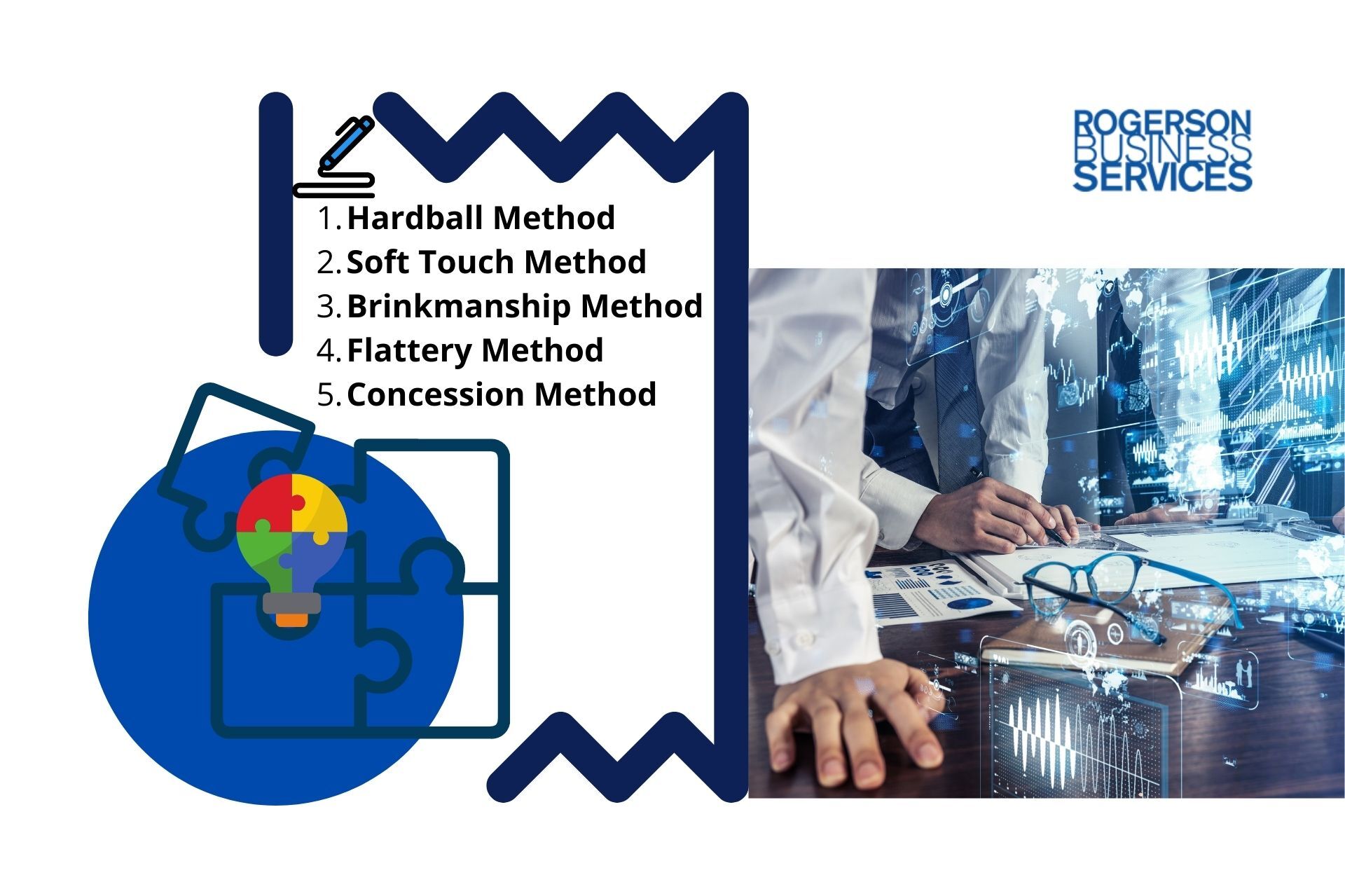5 Negotiation Strategies & Tactics to Win | M&A Deal Structure
5 Negotiation Strategies
5 negotiation strategies in business that will help you sell your lower middle market business on your own terms and conditions with the help of the M&A Deal Team.
- Hardball Method
- Soft Touch Method
- Brinkmanship Method
- Flattery Method
- Concession Method

“I’m ready to sell my business.” This thought has been crossing your mind several times recently.
But do you want to increase the chances of selling a business on your terms?
Then let's look at five negotiation strategies in business that will help you sell your business on terms that suit you best with the help of the M&A Deal Team.
1) The Hardball Method
When you use the hardball method, you hold onto your price and position without getting distracted by the buyer's opinion. The style of negotiation requires you to demand what you want aggressively.
Do Your Homework
Know your goals, the history of the business, and why you're selling. Stay focused by clarifying your negotiating strategy before getting into hard bargaining. Research what company features the buyer looks for to know how to play your game.
Belittle Your Counterpart's Alternatives
Using the hardball method, you must be willing to use everything you have at your disposal to get the sale. You must make a credible case that you are the best option for your business.
When competing with another interested party, point out how that alternative is not as good for the buyer as your business.
Issue Extreme Demands
When a buyer wants to downgrade from your suggested negotiation price, it's wise to stand firm and not budge. The hardball method in M&A negotiation techniques will help you get a better deal for your lower-middle-market business.
For instance, if a buyer is interested in your business but needs more time to evaluate, point out that you are starting talks with other buyers. The buyer will feel pressured into taking the deal.
2) The Soft Touch Method
Using a negotiation strategy known as the soft-touch method is the opposite of the hardball method. Instead of aggressively making your point, the soft-touch process is about creating a relaxed atmosphere and cooperating for tactical negotiations that benefit both parties.
Friendly Dialogue
As you start the negotiation, make your tone one of collaboration and not confrontation. Utilize an informal negotiation style in your speech to relax the atmosphere.
Ignore Any Intimidation
When a buyer makes threats or uses other methods of intimidation, use the soft-touch method. Don't show that you are intimidated by the buyer's actions. Be polite and acknowledge that you will listen to the buyer's concerns.
Respond In Kind
The soft-touch method in M&A negotiation tactics will help keep tensions and hostility down as you negotiate until both parties benefit from the sale. For example, if buyers need more time to make an offer, give them until the next meeting to get what they need.
3) The Brinkmanship Method
To make a sale using the brinkmanship method, you must trick the counterpart into thinking you will walk away from a deal if the terms aren't in your favor.
Offer Take-It-Or-leave-It Options
When the buyer is unwilling to go to terms that suit you, make it clear that you're not willing to compromise. Tell the buyer you are only selling your lower-middle-market business if they agree to your terms, or you will walk away from the deal entirely.
Bluff and Be Prepared To Walk Away
When you use the brinkmanship negotiation strategy, you must be prepared to go through with your threat. If the other party is still stubborn about the terms of the sale, it may be time to walk away.
Don’t Take It Too Far
Don't let the strategy negotiation end without trying to find common ground with your counterpart. Be prepared to return to the bargaining table if the other party makes concessions.
4) The Flattery Method
Through the flattery strategy for negotiation, you use your knowledge and experience to get a better deal by complementing the buyer. When your counterpart gets more impressed by you, they will be more willing to compromise.
Frame Flattery as Likely To Make the Recipient Uncomfortable
The flattery tactics for negotiation will work best if you frame your comments as likely to make the buyer uncomfortable. Be careful when using this negotiating strategy, as it creates an environment of uncertainty and misaligned expectations.
Compliment the Recipient Around Their Associates
When you use flattery in M&A negotiations, complimenting your counterpart near their associates may be even more effective.
Argue a Little Before Conforming to the Subject’s Viewpoint
The flattery negotiating tactics will work best if you can find common ground. However, there is a fine line between making new suggestions and being overly provocative. A well-thought-out flattery approach will help you reach an agreement beneficial to both parties.
5) The Concession Method
In concession negotiation tactics, you make a minor compromise to the buyer to help them feel more comfortable about the deal to help you reach a decision that satisfies both sides of the negotiation.
Keep Track of Your Concessions
Keep track of your concessions so the buyer doesn't take advantage of the deal. If you offer favorable buyer terms in return for signing on now, mark down that concession, so it is clear to your counterpart that you are sacrificing something for them.
Demand and Define Reciprocity
You must specify what you want when making a concession and ensure that your counterpart honors it to avoid future misunderstandings.
Make Concessions in Installments
This method will work best if you offer concessions in installments. Even though you've been as kind as possible, the other person might believe you're holding back if you make your first offer a complete giveaway.
M&A Negotiation Tactics
A few key tactics can help you win when negotiating an M&A deal. Let's look at five tactics to keep in mind.
Know Your Goals and Priorities
Before you can succeed at negotiating an M&A deal, you need to know your goals and priorities.
The more attention you give to your goals, the more likely you will reach an agreement that's a win-win for both parties. You should decide beforehand where you are willing to compromise and where not, for example in terms of price, terms, deadlines, etc.
Research Your Opponent
To understand the strengths and weaknesses of your counterpart, conduct research on their organization and the industry. The study will help you negotiate through an M&A deal structure mutually beneficial to both sides.
Try to look into previous deals to find out about their negotiation style, for instance.
Stay Calm and Assertive
When you negotiate an M&A deal, stay calm and assertive. You need to remain confident to avoid unnecessary compromises and damaging built relationships.
If the other party is showing aggressiveness, for instance, don’t let that affect you emotionally. It’s just a negotiation.
Use Positive Reinforcement
When negotiating an M&A deal, positive reinforcement is an effective tactic to keep the party on your side and make clients less likely to back away from negotiations.
Use it to persuade your counterpart to agree with your suggestions. Thank them if they show a willingness to concede.
Be Prepared To Walk Away
When negotiating, you must be prepared to walk away from the talks when your buyer doesn't agree to the terms. If they’re not willing to concede on something crucial to you, it’s best to walk away.
Considering Selling Your Business? Get a Deal Team of Advisors on Your Side
If you’re looking to sell a business, consider an M&A advisor’s broad knowledge and experience in the industry when considering who to hire as your advisor.
Sell-side advisors can predict potential points of disagreement and advise you on how to renegotiate or walk away from the transaction.
Final Take: Ready to Sell or Not
If you are a retiring business owner looking to exit your lower middle market business in California, here are five tips to get you started:
1. Don't wait until the last minute to start planning your exit. The process of selling a lower middle market business can take a long time, so it's important to start early.
2. Have a clear idea of what you want to get out of the sale. Know your goals and what you're willing to negotiate.
3. Choose the right type of buyer. Not all buyers are created equal, so do your research and find the right one for your business.
4. Be prepared for a lot of due diligence. M&A buy-side due diligence is when Buyers will want to know everything about your business, so be ready to provide documentation and answer questions.
5. Be flexible with the terms and conditions of the deal. It's important to be open to negotiation to get the best possible deal for your business.
Rogerson Business Services, also known as, California's lower middle market business broker is a sell-side M&A advisory firm that has closed many of lower middle-market deals in California. We are dedicated to helping our clients maximize value and achieve their desired outcomes.
We have a deep understanding of the Californian market and an extensive network of buyers, which allows us to get the best possible price for our clients. We also provide comprehensive support throughout the entire process, from initial valuation to post-closing integration.
Our hands-on approach and commitment to our client's success set us apart from other firms in the industry. If you consider selling your lower middle market business, we would be honored to help you navigate the process and realize your goals.
If you have decided to value and then sell your lower middle market business or still not ready, get started here, or call Andrew Rogerson, Certified M&A Advisor, so we can understand your pain points better and prioritize your inquiry with Rogerson Business Services, RBS Advisors.
This is part of hiring an M&A Deal Team tips to answer some FAQs about the deal structure & transaction series ->
Hey there! Can we send you a gift?
We just wanted to say hi and thanks for stopping by our little corner of the web. :) we'd love to offer you a cup of coffee/tea, but, alas, this is the Internet.
However, we think you'll love our email newsletter about building value and properly position your company before transition/exit your business ownership.
As a special welcome gift for subscribing, you'll also get our helping and educational guides, tips, tutorials, etc.. for free.
It's filled with the best practices for retiring serial business owners like Dan Gilbert, Larry Ellison, Warren Buffett, and many more.
Just sign up for our emails below.


